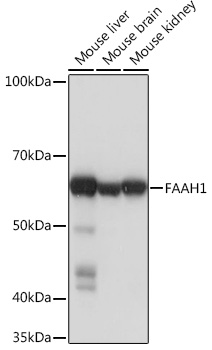Cell Biology Antibodies 17
Anti-FAAH1 Antibody (CAB4099)
- SKU:
- CAB4099
- Product Type:
- Antibody
- Reactivity:
- Human
- Reactivity:
- Mouse
- Reactivity:
- Rat
- Host Species:
- Rabbit
- Isotype:
- IgG
- Research Area:
- Cell Biology
Description
| Antibody Name: | Anti-FAAH1 Antibody |
| Antibody SKU: | CAB4099 |
| Antibody Size: | 20uL, 50uL, 100uL |
| Application: | WB IF |
| Reactivity: | Human, Mouse, Rat |
| Host Species: | Rabbit |
| Immunogen: | A synthesized peptide derived from human FAAH1 |
| Application: | WB IF |
| Recommended Dilution: | WB 1:500 - 1:2000 IF 1:50 - 1:200 |
| Reactivity: | Human, Mouse, Rat |
| Positive Samples: | Mouse liver, Mouse brain, Mouse kidney, HepG2, U-251MG, Rat liver |
| Immunogen: | A synthesized peptide derived from human FAAH1 |
| Purification Method: | Affinity purification |
| Storage Buffer: | Store at -20'C. Avoid freeze / thaw cycles. Buffer: PBS with 0.02% sodium azide, 0.05% BSA, 50% glycerol, pH7.3. |
| Isotype: | IgG |
| Sequence: | Email for sequence |
| Gene ID: | 2166 |
| Uniprot: | O00519 |
| Cellular Location: | |
| Calculated MW: | 63kDa |
| Observed MW: | 63KDa |
| Synonyms: | FAAH-1, PSAB |
| Background: | This gene encodes a protein that is responsible for the hydrolysis of a number of primary and secondary fatty acid amides, including the neuromodulatory compounds anandamide and oleamide. [provided by RefSeq, Jul 2008] |
| UniProt Protein Function: | FAAH: Degrades bioactive fatty acid amides like oleamide, the endogenous cannabinoid, anandamide and myristic amide to their corresponding acids, thereby serving to terminate the signaling functions of these molecules. Hydrolyzes polyunsaturated substrate anandamide preferentially as compared to monounsaturated substrates. Homodimer. Highly expressed in the brain, small intestine, pancreas, skeletal muscle and testis. Also expressed in the kidney, liver, lung, placenta and prostate. Inhibited by O-aryl carbamates and alpha-keto heterocytes. Belongs to the amidase family. |
| UniProt Protein Details: | Protein type:EC 3.5.1.99; Membrane protein, integral; Hydrolase Chromosomal Location of Human Ortholog: 1p35-p34 Cellular Component: cytoskeleton; cytoplasm; integral to membrane; endomembrane system Molecular Function:fatty acid amide hydrolase activity; carbon-nitrogen ligase activity, with glutamine as amido-N-donor; acylglycerol lipase activity Biological Process: fatty acid catabolic process Disease: Polysubstance Abuse, Susceptibility To |
| NCBI Summary: | This gene encodes a protein that is responsible for the hydrolysis of a number of primary and secondary fatty acid amides, including the neuromodulatory compounds anandamide and oleamide. [provided by RefSeq, Jul 2008] |
| UniProt Code: | O00519 |
| NCBI GenInfo Identifier: | 60416391 |
| NCBI Gene ID: | 2166 |
| NCBI Accession: | O00519.2 |
| UniProt Related Accession: | O00519 |
| Molecular Weight: | ~ 63kDa |
| NCBI Full Name: | Fatty-acid amide hydrolase 1 |
| NCBI Synonym Full Names: | fatty acid amide hydrolase |
| NCBI Official Symbol: | FAAH |
| NCBI Official Synonym Symbols: | PSAB; FAAH-1 |
| NCBI Protein Information: | fatty-acid amide hydrolase 1 |
| UniProt Protein Name: | Fatty-acid amide hydrolase 1 |
| UniProt Synonym Protein Names: | Anandamide amidohydrolase 1; Oleamide hydrolase 1 |
| Protein Family: | Fatty-acid amide hydrolase |
| UniProt Gene Name: | FAAH |
| UniProt Entry Name: | FAAH1_HUMAN |
View AllClose







